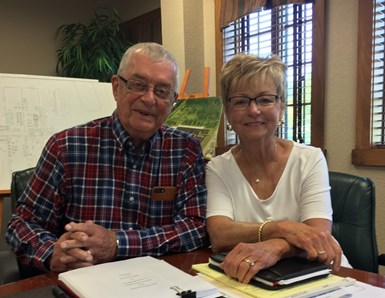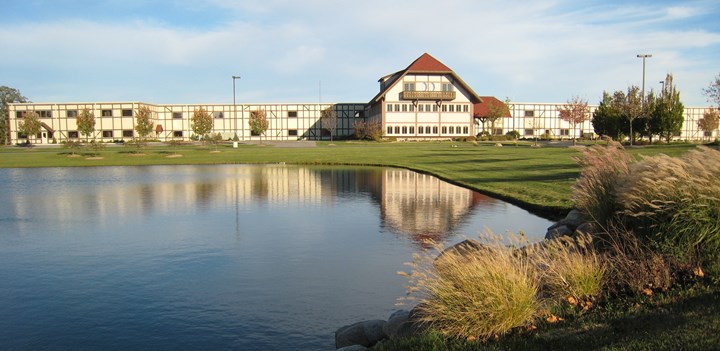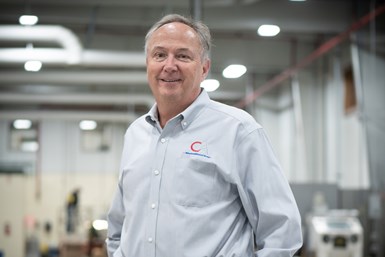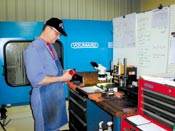Share




Like the genetic material that determines the characteristics of a living organism, the core vision and values of a company’s leadership direct its growth and sustain its viability. The truest test of a company’s “DNA” may be the ability to retain these essential traits when there is transition in top management.
There is perhaps no stronger example of these statements than C&A Tool Engineering Inc., a contract manufacturing company in Churubusco, Indiana (not far from Fort Wayne in the northeast corner of the state). It has been featured in several Modern Machine Shop articles as well as a piece in MMS sister publication Additive Manufacturing. All these articles detail accomplishments that can be attributed directly to the bold and insightful management style of Dick Conrow.
Mr. Conrow founded the company in 1969 in his one-car garage. During his tenure, he proved to be a visionary manager, a seemingly fearless innovator, a bold investor in shop equipment, and a highly respected (even beloved) leader of the company.
I first wrote about C&A and its unusual qualities in The Radicals of Churubusco, the cover story of our December 1990 print issue. As that article tried to show, C&A did things differently, and largely because Mr. Conrow saw things differently. I never looked at manufacturing the same way after seeing “the C&A way.”
I found Mr. Conrow to be perceptive, articulate and profoundly wise. He could be blunt, yet always humane and sympathetic. I was amazed by his relentless energy and even more impressed by his unshakable belief in the importance and goodness of manufacturing. From what I could tell, he never lost his instincts as an old-style toolmaker.
For the 48 years he was C&A’s top leader, the power of certain principles is what mattered to him. The success of C&A is primarily a result of adhering to these principles. What started in a garage is now a diversified manufacturing organization with more than 650 employees, some 700,000 square feet of production space and more than $100 million in annual sales.

Dick Conrow, now 80, and his wife Sara enjoy a modest retirement lifestyle in Churubusco, their lifelong hometown. All photos are courtesy of C&A Tool.
Mr. Conrow retired at the end of 2018 at the age of 78, following the sale of C&A to the MinebeaMitsumi Group (Tokyo, Japan), as part of the New Hampshire Ball Bearing/Myonic Business Unit. His longtime associate and vice president, Rob Marr, became the new president and CEO. Fortunately, the new corporate owners insist that C&A stick to the principles established by
Mr. Conrow and embraced by Mr. Marr. C&A, it seems, is now moving ahead, with the best of Mr. Conrow’s ideas about manufacturing, his principles of leadership and his energetic spirit as an ongoing legacy.
Radically Different
Looking back, it is apparent that I “discovered” the DNA of C&A on my first tour of its facilities some 30 years ago. At the beginning of the resulting article, I noted that this is a tool and die shop that also does production work. It has successfully married the traditional, one-mold-at-a-time work with a “parts business” — orders for mid- to high-volume lots that often repeat on a regular basis.
At the time, C&A’s “Das Schleifhaus” (German for “the grinding house”) had more top-of-the-line precision grinders from Switzerland than any other U.S. company. Mr. Conrow explained that the ability to grind with extremely close tolerances opens new markets and brings a tremendous confidence when working with modern quality requirements. “If you have the precision available, it is ideal for not only tool and die work, but also for many production jobs: small to medium batch sizes with close tolerances and fine finishes,” he said.
From an equipment standpoint, mixing tool and die work with production jobs was possible and profitable. But Mr. Conrow saw an even more important reason: The mix was good for the people in the shop, and what is good for the people in the shop is good for business. Tool and die work builds skills; production jobs build proficiency. Tool and die work can be challenging and a change of pace; production jobs provide continuity and just enough routine.
Mr. Conrow’s leadership style continues to influence how this high-precision equipment is applied. In the article, I summarized what he told me about his approach in this way: “Dick Conrow doesn’t believe in supervisors. ‘Why should I pay someone to watch other people do the work?’ He doesn’t believe in management, at least not in the conventional sense. ‘Management means control. Nobody wants to be controlled.’ Instead, he believes in the people who work with him. ‘They know their jobs. I trust them. I don’t have to make decisions for them.’ He also believes in respect. ‘Everybody here has to find his or her own level and not feel diminished, whatever that level might be. My job is to help them make the most of their individual strengths and not get in the way.’”
“My job is to help them make the most of their individual strengths and not get in the way.”

It has been possible for C&A to adapt the blending of tool and die work with production jobs for decades, even as CNC machining technology continually advanced in capability and complexity. Today, this scene of CNC machining area is representative of the company’s operations — a blend of capable machines and capable operators.
He went on to explain that operators were perfectly free to balance the tooling side and the production side of their work on their own terms. They set their own schedules and chose their own jobs. They made their own commitment to finishing work on time, and decided for themselves what overtime, if any, might be required to meet due dates. They took responsibility for the quality of their work, using the inspection room as needed.
We know that DNA (deoxyribonucleic acid) is a molecule present in virtually every cell of a living organism and is the main constituent of chromosomes. This molecule (famously shaped as a double helix) carries genetic instructions that enable cells, and thus entire organisms, to develop, function, grow and reproduce. Thanks to DNA and its ability to replicate itself, genetic traits can be passed on. When I returned to C&A five years later for a second article, I found a similar process at work: The company had grown and changed, but it also had retained its essential traits.
Roots That Spread
That 1995 article was appropriately titled Radicals Revisited. By that point,
C&A had grown to occupy a collection of integrated manufacturing buildings that Mr. Conrow called an “industrial village.” At the time, this village represented five interrelated “area disciplines” of tooling projects, CNC milling, CNC lathes, cylindrical grinding and engineering. Metal preparation and maintenance also were housed in their own buildings.
Whether one viewed these departmental buildings individually or as parts of as an unusually dynamic job shop, it was obvious that the underlying DNA had not changed. For example, there were no supervisors, only “go-to” people (more experienced individuals who have ideas or solutions to share when needed). Operators still decided as a team how schedules were set and jobs assigned. Each operator was still responsible for producing and verifying the quality of his or her own work.
However, each department also drew on and built on the resources of the others. Much of this interaction and cooperation occurred in what Mr. Conrow referred to as the “war room,” an informal conference area and cluster of open offices on the first floor of several connected storefronts cornering on Churubusco’s Main Street. This war room is where project teams (representatives from each department involved in the work) met to accept, plan and coordinate inter-departmental activities.
At the time, commenting on this industrial village, Mr. Conrow made a point he believed in wholeheartedly: “It’s not how you group the machines that counts, it’s how you group the people.” Thus, the industrial village gave C&A what he said was the best of both worlds. The synergy and efficiency of having like machines and their expert operators together is maintained on one hand. On the other, these inter-departmental, multi-discipline teams function as virtual manufacturing cells that can be readily reconfigured to meet the situation.
“It’s not how you group the machines that counts, it’s how you group the people.”
Most importantly, the village was a community inhabited by skilled tool and die makers — whether individuals were engaged in tool work per se or simply applied a tool room mentality and ethic to whatever their position required.
Before I left, Mr. Conrow shared the news that C&A was planning to move the production work to a new facility. That move would enable the tool and die work to expand into freed-up space in downtown Churubusco. The question in my mind was whether this split might cause serious “genetic damage” to the company. Another five years later, I found C&A’s DNA as intact and impactful as ever.
No Gene Splitting
In 1990, Das Schliefhaus at C&A featured an exterior decor strongly reminiscent of a Swiss chalet. Mr. Conrow wanted to convey the aura of Swiss precision and traditional craftsmanship, the two “traits” he esteemed in the high-end grinders from the German-speaking part of Switzerland. The new Fraeshaus (milling house) that I saw in 1995 also resembled a chalet.
So, I was not surprised to see that C&A’s newer production facility, called the South Building, bore the same distinctive styling. Half-timbered walls and fish-scale shingles on the roof of the front-office portion gave it a quaint, Old World look. The inside also evidenced C&A’s characteristic philosophy of sticking to its tool and die roots. As Mr. Conrow explained to me, “Designing a production facility from scratch gave us the chance to do it the way we think it ought to be done, as the logical extension of our expertise in the tooling area. The building itself is part of our capability. It helps us do what we need to do.”

C&A’s South Building, opened in 1999 and expanded substantially since then, bears a distinctive styling, which is in keeping with the distinctive style of management and leadership applied on the inside. The company has numerous manufacturing facilities in the Churubusco area.
The building is roughly shaped like the letter “H.” Each leg of the H contains distinct machining areas or “pods,” devoted to a particular process — milling, turning, grinding and automatic machining. Mr. Conrow insisted that the pods are not cells and that “cellular manufacturing” was not the strategy. “The whole darn plant is cell,” he said. The machine tools installed in the building had tool changers, pallet shuttles, bar feeders, gantry loaders, and so on to minimize direct labor. Tactically, each pod can be reconfigured by adding, changing or rearranging machine tools within it. For this reason, machines that are “redeployable” had been favored over dedicated but less flexible machines.
The central service corridor forms the cross arm of H and facilitates traffic throughout the building. The metrology lab and the tool crib are located along one side of the corridor for access from the rest of the plant. The cafeteria, first aid station, janitorial department and washroom are located along the other side.
On a strategic level, the building’s flexibility supports C&A’s essential mission to be a tool and die house with production capability. It can develop a prototype, engineer the manufacturing process, design and build the tooling (molds, dies, fixtures, special cutters, gages and so on), prove out the process and run full or partial production to suit the customer.
The building’s amenities are also notable. This sends a a number of important messages:
- That the people deserve an attractive and comfortable setting, whether they work at a machine or at a desk.
- That the organization values the individual’s contribution and supports it earnestly.
- That self-respect and pride influence product quality, so a work setting should reflect the company’s respect for and pride in the individual.
Finally, Mr. Conrow noted that the building was designed for expansion, quickly adding that however much these part making operations may grow, the company remained committed to its toolmaking tradition. “Expert toolmaking is the heart and soul of this company. We’ll be successful at part making to the extent we remain successful at toolmaking. You can’t have one without the other.”
The Additive (R)evolution
I made one more trip to C&A in 2013 with Pete Zelinski, who was then spearheading content development for MMS sister publication Additive Manufacturing.

Given its long history of investing in the latest CNC technology, the company’s embrace of additive manufacturing was “common sense,” in Mr. Conrow’s judgment. This is one of C&A’s newest selective laser sintering machines from EOS.
By then, C&A employed more than 500 people and occupied facilities totaling more than 700,000 square feet. I had tagged along to make introductions and catch up while Pete took the lead in investigating what C&A had learned about additive manufacturing since installing four direct metal laser sintering machines. Despite the shop’s success in CNC machining, Mr. Conrow said that embracing additive manufacturing was common sense. Part making will move in this direction, he predicted confidently.
Mr. Conrow and his expert colleagues had much to show us. The richest information came from discussing practical insights gained producing several particularly challenging workpieces. One tip was to nest as many parts on a plate as possible, not only to reduce total overall build time, but also to accommodate customer requests for a single part requiring rapid turnaround. Another was to slice a part so that sections could be built side-by-side to avoid tasking the machine with using its full Z-axis dimension. One part design could not be produced at all with other manufacturing processes.
All these insights resulted from approaching additive manufacturing with the mindset of a toolmaker — considering how to achieve and maintain straightness, roundness, location tolerances and so on. Additive processes simply imposed different considerations for how to reach those goals.
One more point he made came to me like a familiar echo. Additively manufactured parts typically were not ready to ship without judicious use of subtractive machining processes. “I don’t see how you could succeed at additively manufacturing without superb CNC machining capability.”
Here again, the mix of toolmaking and production was not only a meeting of expert minds, but also the perfect blending of manufacturing methods.
The Same, Yet New
Mr. Marr succeeded Mr. Conrow as the top leader at C&A in September 2017. I met Mr. Marr, who joined the company in 1982, during my first visit. His long association with the company and its remarkably pragmatic founder is significant. As the new president, he represents both continuity and adaptability.

When Rob Marr succeeded Mr. Conrow as president and CEO, there was little shift away from core principles that previously had guided the company, although it has adapted smoothly to changes in the manufacturing environment. Mr. Marr expects this continuity to be maintained, even he eyes the transition that will occur at his own retirement in the years ahead.
He recognizes that some things about the C&A way must change in response to new challenges and opportunities. He also grasps that some deep-rooted strengths of the company must be carefully preserved, even promoted. Most importantly of all, he understands that he has to be “his own man” and trust his leadership instincts and personal style.
Recently, he outlined the ways C&A is the same, yet different as its DNA manifests itself in an age of digitalization, globalization and integration.
- Training. Employee training is a mix of technical classes hosted by the local branch of Ivy Tech, Indiana’s state-wide vocational system, and on-the-job experience. Because most manufacturing processes are increasingly complex and demanding, there has been an inevitable trend to greater specialization on the shop floor. Cross training, where practical, helps specialists understand other specialists at complementary processes so they can serve one another better.
- Machine monitoring/data collection. A pilot program is underway as an “operator-owned” resource to make machine performance more transparent and production planning more effective because it is based on reliable data.
- Collaboration. A current focus is on greater collaboration between the company’s business units. One goal is to make available machine hours in one unit more accessible to other departments. Leveraging complementary strengths among units is seen as a growth opportunity. Better coordination of decision-making and planning is another benefit.
- Larger lean. Continuous improvement efforts are now more likely to solicit input from suppliers and outside technical support and have their representatives included in value stream mapping or brainstorming. Strengthening communication and collaboration has enabled many of the company’s smaller facilities to be consolidated, often as cells for smoother workflow.
- Customer value-adds. Testing, kitting, assembly and packaging are the fastest-growing areas for the company. Many medical parts are being delivered ready for stocking at end-user sites.
- Business support. Today, running a $100 million job shop calls for a formal, structured approach to sales, human resource management and legal counsel. Strengthening these essential functions provides a solid framework to support C&A as a business in the business of making things.
- A world view. The new parent company gives C&A worldwide partnering opportunities as well as insight into world-class manufacturing technology. Nevertheless, the company hasn’t lost sight of its hometown roots and sees them as a source of pride and stability.
Just as DNA defines a being at it’s core, a legacy of leadership continues to define C&A. “We know what made C&A successful in the past,” Mr. Marr says. “We believe it is a good formula for success in the future. By focusing on prototype and development programs, we keep tool and die skills sharp, and that keeps us on the cutting edge of production technology. Sticking to this makes us distinctive; it separates us from the competition.”
Related Content
DN Solutions Responds to Labor Shortages, Reshoring, the Automotive Industry and More
At its first in-person DIMF since 2019, DN Solutions showcased a range of new technologies, from automation to machine tools to software. President WJ Kim explains how these products are responses to changes within the company and the manufacturing industry as a whole.
Read MoreInside Machineosaurus: Unique Job Shop with Dinosaur-Named CNC Machines, Four-Day Workweek & High-Precision Machining
Take a tour of Machineosaurus, a Massachusetts machine shop where every CNC machine is named after a dinosaur!
Read MoreHow to Pass the Job Interview as an Employer
Job interviews are a two-way street. Follow these tips to make a good impression on your potential future workforce.
Read MoreIn Moldmaking, Mantle Process Addresses Lead Time and Talent Pool
A new process delivered through what looks like a standard machining center promises to streamline machining of injection mold cores and cavities and even answer the declining availability of toolmakers.
Read MoreRead Next
A Radically Different Production Plant
From the outside, it looks somewhat like a resort hotel. From the inside, it isn’t set up like any job shop you’ve probably ever seen.
Read More






























